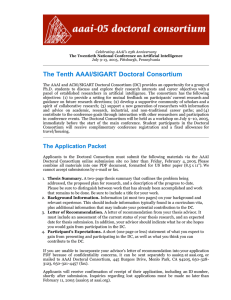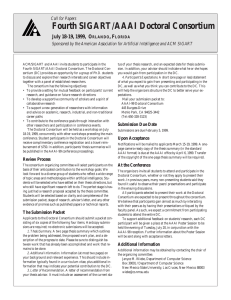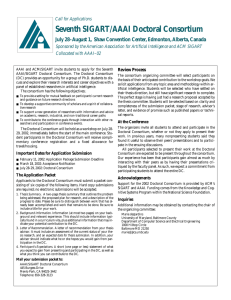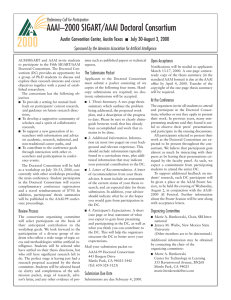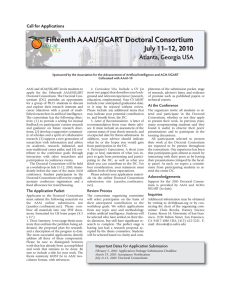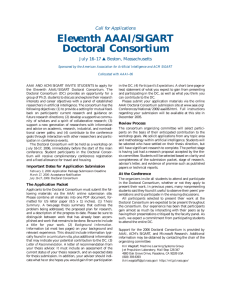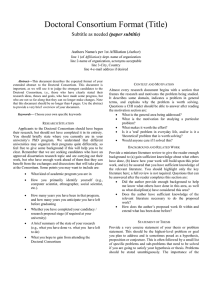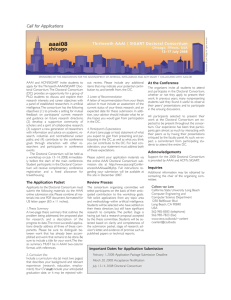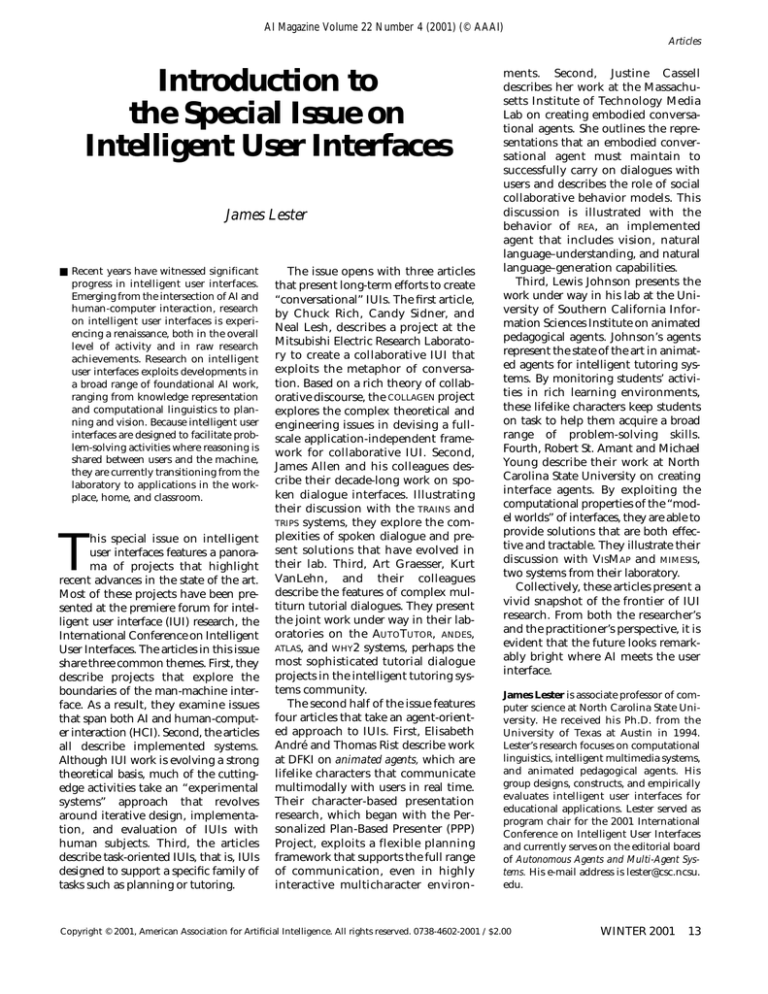
AI Magazine Volume 22 Number 4 (2001) (© AAAI)
Articles
Introduction to
the Special Issue on
Intelligent User Interfaces
James Lester
■ Recent years have witnessed significant
progress in intelligent user interfaces.
Emerging from the intersection of AI and
human-computer interaction, research
on intelligent user interfaces is experiencing a renaissance, both in the overall
level of activity and in raw research
achievements. Research on intelligent
user interfaces exploits developments in
a broad range of foundational AI work,
ranging from knowledge representation
and computational linguistics to planning and vision. Because intelligent user
interfaces are designed to facilitate problem-solving activities where reasoning is
shared between users and the machine,
they are currently transitioning from the
laboratory to applications in the workplace, home, and classroom.
T
his special issue on intelligent
user interfaces features a panorama of projects that highlight
recent advances in the state of the art.
Most of these projects have been presented at the premiere forum for intelligent user interface (IUI) research, the
International Conference on Intelligent
User Interfaces. The articles in this issue
share three common themes. First, they
describe projects that explore the
boundaries of the man-machine interface. As a result, they examine issues
that span both AI and human-computer interaction (HCI). Second, the articles
all describe implemented systems.
Although IUI work is evolving a strong
theoretical basis, much of the cuttingedge activities take an “experimental
systems” approach that revolves
around iterative design, implementation, and evaluation of IUIs with
human subjects. Third, the articles
describe task-oriented IUIs, that is, IUIs
designed to support a specific family of
tasks such as planning or tutoring.
The issue opens with three articles
that present long-term efforts to create
“conversational” IUIs. The first article,
by Chuck Rich, Candy Sidner, and
Neal Lesh, describes a project at the
Mitsubishi Electric Research Laboratory to create a collaborative IUI that
exploits the metaphor of conversation. Based on a rich theory of collaborative discourse, the COLLAGEN project
explores the complex theoretical and
engineering issues in devising a fullscale application-independent framework for collaborative IUI. Second,
James Allen and his colleagues describe their decade-long work on spoken dialogue interfaces. Illustrating
their discussion with the TRAINS and
TRIPS systems, they explore the complexities of spoken dialogue and present solutions that have evolved in
their lab. Third, Art Graesser, Kurt
VanLehn, and their colleagues
describe the features of complex multiturn tutorial dialogues. They present
the joint work under way in their laboratories on the AUTOTUTOR, ANDES,
ATLAS, and WHY2 systems, perhaps the
most sophisticated tutorial dialogue
projects in the intelligent tutoring systems community.
The second half of the issue features
four articles that take an agent-oriented approach to IUIs. First, Elisabeth
André and Thomas Rist describe work
at DFKI on animated agents, which are
lifelike characters that communicate
multimodally with users in real time.
Their character-based presentation
research, which began with the Personalized Plan-Based Presenter (PPP)
Project, exploits a flexible planning
framework that supports the full range
of communication, even in highly
interactive multicharacter environ-
ments. Second, Justine Cassell
describes her work at the Massachusetts Institute of Technology Media
Lab on creating embodied conversational agents. She outlines the representations that an embodied conversational agent must maintain to
successfully carry on dialogues with
users and describes the role of social
collaborative behavior models. This
discussion is illustrated with the
behavior of REA, an implemented
agent that includes vision, natural
language–understanding, and natural
language–generation capabilities.
Third, Lewis Johnson presents the
work under way in his lab at the University of Southern California Information Sciences Institute on animated
pedagogical agents. Johnson’s agents
represent the state of the art in animated agents for intelligent tutoring systems. By monitoring students’ activities in rich learning environments,
these lifelike characters keep students
on task to help them acquire a broad
range of problem-solving skills.
Fourth, Robert St. Amant and Michael
Young describe their work at North
Carolina State University on creating
interface agents. By exploiting the
computational properties of the “model worlds” of interfaces, they are able to
provide solutions that are both effective and tractable. They illustrate their
discussion with VISMAP and MIMESIS,
two systems from their laboratory.
Collectively, these articles present a
vivid snapshot of the frontier of IUI
research. From both the researcher’s
and the practitioner’s perspective, it is
evident that the future looks remarkably bright where AI meets the user
interface.
James Lester is associate professor of computer science at North Carolina State University. He received his Ph.D. from the
University of Texas at Austin in 1994.
Lester’s research focuses on computational
linguistics, intelligent multimedia systems,
and animated pedagogical agents. His
group designs, constructs, and empirically
evaluates intelligent user interfaces for
educational applications. Lester served as
program chair for the 2001 International
Conference on Intelligent User Interfaces
and currently serves on the editorial board
of Autonomous Agents and Multi-Agent Systems. His e-mail address is lester@csc.ncsu.
edu.
Copyright © 2001, American Association for Artificial Intelligence. All rights reserved. 0738-4602-2001 / $2.00
WINTER 2001
13
Call for Applications
Seventh SIGART/AAAI Doctoral Consortium
July 28–August 1, Shaw Convention Center, Edmonton, Alberta, Canada
Sponsored by the American Association for Artificial Intelligence and ACM SIGART
Collocated with AAAI–02
AAAI and ACM/SIGART invite students to apply for the Seventh
AAAI/SIGART Doctoral Consortium. The Doctoral Consortium
(DC) provides an opportunity for a group of Ph.D. students to discuss and explore their research interests and career objectives with a
panel of established researchers in artificial intelligence.
The consortium has the following objectives:.
To provide a setting for mutual feedback on participants’ current research
and guidance on future research directions
■ To develop a supportive community of scholars and a spirit of collaborative research
■ To support a new generation of researchers with information and advice
on academic, research, industrial, and non-traditional career paths
■ To contribute to the conference goals through interaction with other researchers and participation in conference events.
■
The Doctoral Consortium will be held as a workshop on July 2829, 2002, immediately before the start of the main conference. Student participants in the Doctoral Consortium will receive complimentary conference registration and a fixed allowance for
travel/housing.
Important Dates for Application Submission
■
■
■
February 11, 2002: Application Package Submission Deadline
March 18, 2002: Acceptance Notification
July 28-29, 2002: Doctoral Consortium
The Application Packet
Applicants to the Doctoral Consortium must submit a packet consisting of six copies of the following items. Hard copy submissions
are required; no electronic submissions will be accepted.
1. Thesis Summary. A two-page thesis summary that outlines the problem
being addressed, the proposed plan for research, and a description of the
progress to date. Please be sure to distinguish between work that has already been accomplished and work that remains to be done. Be sure to
include a title for your work.
2. Background Information. Information (at most two pages) on your background and relevant experience. This should include information typically found in a curriculum vita, plus additional information that may indicate your potential contribution to the DC.
3. Letter of Recommendation. A letter of recommendation from your thesis
advisor. It must include an assessment of the current status of your thesis research, and an expected date for thesis submission. In addition, your
advisor should indicate what he or she hopes you would gain from participation in the DC.
4. Participant’s Expectations. A short (one page or less) statement of what
you expect to gain from presenting and participating in the DC, as well as
what you think you can contribute to the DC.
Mail your submission packet to:
AAAI/SIGART Doctoral Consortium
445 Burgess Drive
Menlo Park, CA 94025-3442
Telephone: 650-328-3123
14
AI MAGAZINE
Review Process
The consortium organizing committee will select participants on
the basis of their anticipated contribution to the workshop goals. We
solicit applications from any topic area and methodology within artificial intelligence. Students will be selected who have settled on
their thesis direction, but still have significant research to complete.
The perfect stage is having just had a research proposal accepted by
the thesis committee. Students will be selected based on clarity and
completeness of the submission packet, stage of research, advisor’s
letter, and evidence of promise such as published papers or technical reports.
At the Conference
The organizers invite all students to attend and participate in the
Doctoral Consortium, whether or not they apply to present their
work. In previous years, many nonpresenting students said they
found it useful to observe their peers’ presentations and to participate in the ensuing discussions.
All participants selected to present their work at the Doctoral
Consortium are expected to be present throughout the consortium.
Our experience has been that participants gain almost as much by
interacting with their peers as by having their presentations critiqued by the faculty panel. As such, we expect a commitment from
participating students to attend the entire DC.
Acknowledgements
Support for the 2002 Doctoral Consortium is provided by ACM’s
SIGART and AAAI. Funding comes from the Knowledge and Cognitive Systems Program within the National Science Foundation.
Inquiries
Additional information may be obtained by contacting the chair of
the organizing committee:
Marie desJardins
University of Maryland, Baltimore County
Department of Computer Science and Electrical Engineering
1000 Hilltop Circle
Baltimore MD 21250
mariedj@cs.umbc.edu

